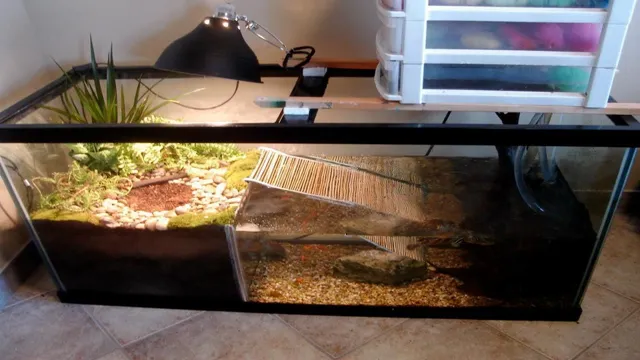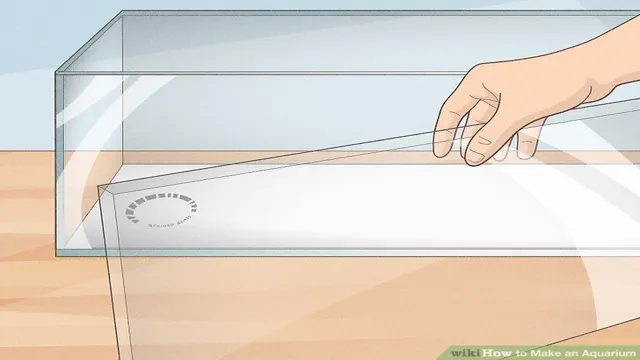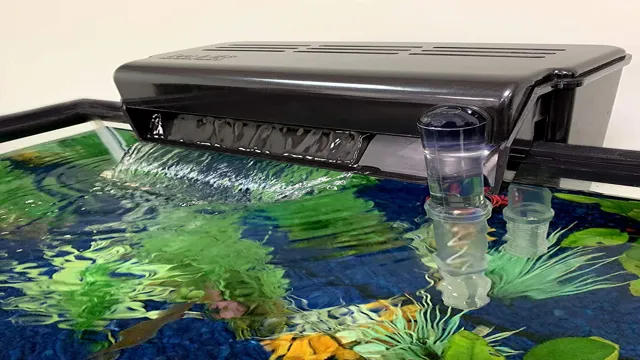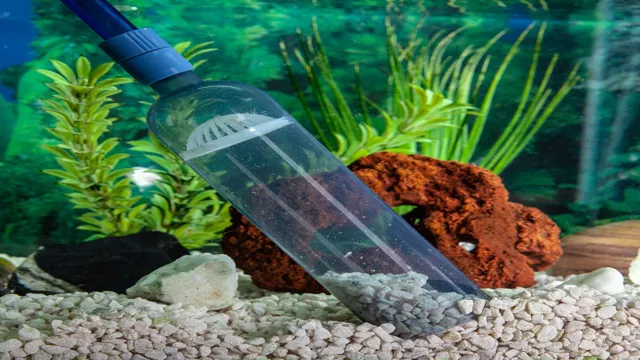How to Make a Semi-Aquatic Aquarium: Tips and Tricks for a Unique Water Terrarium Setup

If you’re looking to create a truly unique aquarium, then consider going semi-aquatic. This type of aquarium is perfect for aquatic creatures that require both land and water to thrive, like turtles, frogs, and crabs. But creating a semi-aquatic aquarium is not as simple as filling a tank with water and adding some rocks.
There are several important factors to consider, such as the type of substrate, lighting, filtration, and of course, the right animals to keep. In this blog, we’ll explore everything you need to know about creating a semi-aquatic aquarium, from choosing the right species to stocking your tank with the essential equipment. So, dive in and let’s get ready to explore this fascinating and rewarding aquarium project!
Choosing the Right Tank
When creating a semi-aquatic aquarium, choosing the right tank is crucial. Firstly, you want to make sure the tank is large enough for your aquatic pets to swim around and land in. Look for tanks with a large surface area as well as depth, providing plenty of space for both fully aquatic and semi-aquatic species.
Secondly, ensure that the tank has a secure lid to prevent escape or curious pets from falling in. Lastly, consider the material of the tank – glass is heavier but more durable, while acrylic is lighter and more resistant to scratches. It is important to select the type of tank based on your own preferences, but also to meet the needs of your aquatic pets.
By taking these factors into account, you can create a comfortable and enriched environment for your aquatic companions to thrive in.
Consider the Size and Shape
When choosing the right tank for your needs, it’s important to consider the size and shape of the tank. The size of the tank will depend on how much water or other liquid you need to store. If you need a large amount of water, then you’ll want to choose a tank with a greater capacity.
The shape of the tank is also important to consider. If you have limited space, then a slimline tank may be more suitable than a round tank. On the other hand, a round tank can have more capacity for the same footprint.
It’s also worth considering the height of the tank, as this can affect how easy it is to access and maintain the tank. Overall, choosing the right tank size and shape will ensure that it meets your needs and fits in with your space requirements.

Types of materials- glass or acrylic?
When it comes to choosing the right tank for your aquatic pets, one of the decisions you’ll need to make is whether to go with glass or acrylic. Glass tanks have been a popular choice for decades, primarily because of their durability and scratch resistance. They’re also generally less expensive than acrylic tanks of the same size.
However, acrylic tanks have gained popularity in recent years due to their lighter weight and impact resistance. Acrylic tanks are also available in a wider range of shapes and sizes, making them a great option for those looking to create a custom aquarium. Ultimately, the choice between glass or acrylic will depend on your individual needs and preferences, but both options can provide a safe and comfortable home for your aquatic pets.
So, think carefully about the needs of your pets and your budget before making a decision.
Choosing the Right Substrate
When it comes to setting up a semi-aquatic aquarium, one of the key factors to consider is the substrate. The type of substrate you choose will not only impact the aesthetic appeal of your tank, but it will also influence the health and well-being of your aquatic pets. Some popular options for semi-aquatic tank substrates include pebbles, gravel, sand, and soil.
Pebbles and gravel are great for adding texture and depth to your tank, while sand is perfect for mimicking the natural ecosystem of certain species. Soil, on the other hand, can help to maintain stable water pH levels and improve plant growth. Consider the needs of your specific species and the environment you want to create, then choose a substrate that meets those requirements.
Remember, a healthy substrate is essential for a healthy and happy semi-aquatic aquarium!
Provide Adequate Drainage
When it comes to creating a healthy and thriving garden, one of the most important factors to consider is adequate drainage. A proper substrate can make all the difference in ensuring that water is able to drain away from the roots, preventing moisture buildup and potential root rot. The right substrate is key to a successful garden, and it’s important to choose a material that will allow water to flow freely through the soil.
Consider options like perlite, vermiculite, or sand, which can help increase drainage and prevent water from becoming stagnant. It’s important to strike a balance, though, as too much drainage can also be harmful for plants. Ensuring that your substrate is both well-draining and nutrient-rich will help your plants thrive, and allow you to cultivate a beautiful and healthy garden.
Types of Substrate- Gravel, sand, etc.
When it comes to setting up an aquarium, choosing the right substrate is an essential aspect to consider. Your substrate will not only influence the aesthetic appeal of your aquarium, but it also plays an essential role in maintaining a healthy environment for your fish and other aquatic creatures. The right substrate depends on the type of animals you plan to keep in your aquarium.
If you have bottom-dwelling fish like corydoras, you may want to choose a fine-grain substrate like sand, which won’t damage their sensitive barbels. For aquariums with live plants, gravel with a diameter of 1-3mm is a great option as it allows essential nutrients and water to circulate through the roots. Keep in mind that the substrate should also match the décor of your aquarium.
While choosing the substrate for your aquarium, ensure to check the compatibility with your fish and plant species to create a thriving underwater environment.
Designing the Land and Water Areas
If you’re interested in creating a semi-aquatic aquarium, designing the land and water areas is a crucial step. Firstly, determine the size of your tank and decide on the ratio of land to water you want to incorporate. You should also consider the type of plants and animals you plan to add to your tank as this can dictate the shape and layout of your landscape.
Next, choose a suitable substrate for both the land and water areas, such as gravel or sand for the aquatic portion and soil or coconut fiber for the land. Consider adding rocks, logs, and other decor to create a natural habitat for your aquarium’s inhabitants. You should also make sure the water and land areas are separated by a secure barrier to prevent soil from getting into the water.
Don’t forget to add a filtration system and a heat source for your semi-aquatic aquarium to ensure the plants and animals thrive in their new environment. By carefully planning and designing the land and water areas, your semi-aquatic aquarium will be a unique and beautiful addition to your home.
Create a Slope for Easy Access
If you want to create easy access to your land or water area, you should consider designing a slope. A slope or a ramp can provide a smooth and gradual incline that makes it easier for people or equipment to enter the area. But, keep in mind that not all slopes are created equal.
You’ll need to design a slope that fits your specific terrain and purpose. For example, if your slope is too steep, it can become dangerous or difficult to navigate. If your slope is too shallow, it might not provide enough traction or stability.
So, it’s essential to find the right balance. You can consult with a professional designer or contractor who can help you create a slope that meets your needs and is also compliant with local regulations. With the right slope design, you can enjoy easy access to your land or water area, and your guests or tenants can move around with ease.
Using Rocks and Wood to Add Natural Elements
Designing the land and water areas of your outdoor space is crucial if you want to create a natural and welcoming atmosphere. Adding natural elements like rocks and wood is an excellent way to enhance the overall aesthetic of your garden or outdoor space. These elements can be used to border or accent different areas, like a pathway leading to a water feature.
Rocks can be placed strategically to create an interesting focal point, while wood can be used to create benches, tables, or even a shaded area. By bringing nature into your design, you can create an inviting area that’s not only beautiful but also eco-friendly. Over time, these natural elements will blend in with their surroundings, forming a seamless connection between your garden and the natural environment.
Adding rocks and wood to your outdoor space is an easy, affordable way to create a natural-looking landscape that is sure to be enjoyed by both people and wildlife.
Choosing the Right Plants and Animals
When creating a semi-aquatic aquarium, one of the most important factors to consider is the choice of plants and animals that will thrive in such an environment. It is important to choose species that can adapt to both water and land conditions. A good starting point would be plants such as water lettuce, water hyacinth, and duckweed, which add oxygen to the water and provide cover and hiding places for aquatic animals.
For animals, it is crucial to select those that can survive in both environments. Red-eared slider turtles, for example, are a popular choice for semi-aquatic setups. They require land to bask on to dry out their shells and water to swim in.
Other species like freshwater crabs and African dwarf frogs are also suitable choices. By selecting the right combination of plants and animals, you can create a thriving and balanced semi-aquatic ecosystem within your aquarium.
Semi-Aquatic Plants
When it comes to creating a semi-aquatic aquarium, choosing the right plants and animals is essential for a thriving ecosystem. Choosing semi-aquatic plants is an excellent starting point. These plants not only add aesthetics but also provide shelter and food for aquatic animals.
One of the best plants you can choose for your semi-aquatic aquarium is Anubias. These plants are easy to care for and don’t require a lot of light, making them perfect for a low light environment. Other great options include Java fern, Amazon sword, and water lilies.
These plants not only offer shelter but also help to purify the water by absorbing excess nutrients. When selecting animals for your aquarium, it’s important to choose species that are compatible with semi-aquatic plants. Not all animals will peacefully coexist with plants, and some may even eat them.
Some good options include cherry shrimp, neon tetras, and guppies. These species are relatively easy to care for and require minimal space, making them ideal for smaller aquarium setups. By choosing the right semi-aquatic plants and animals, you can create a beautiful and thriving ecosystem in your aquarium.
So, if you’re thinking about creating a semi-aquatic environment, consider choosing Anubias, Java fern, Amazon sword, or water lilies, and don’t forget to pick compatible animal species to create a harmonious and beautiful balance.
Semi-Aquatic Animals – fish, turtles, frogs, etc.
When it comes to setting up a semi-aquatic animal habitat, choosing the right plants and animals is crucial for their wellbeing and survival. For fish, it’s important to select plants that provide shelter and hiding spaces, as well as those that offer oxygenation such as water wisteria and hornwort. Turtles require plants that can oxygenate the water and provide a basking area, such as duckweed and water lettuce.
Frogs prefer tall plants like cattails and water lilies that provide hiding spots and shade from the sun. Another important factor to consider when choosing your plants is whether they are toxic to the animals in your habitat. Researching beforehand can save you from inadvertently harming your new pets.
Along with the right plants, it’s also important to choose compatible animals for your habitat. Be sure to research the specific needs and behaviors of each species you plan to include to ensure they can peacefully coexist. With the right plants and animals, your semi-aquatic habitat can thrive and provide a natural and healthy environment for your pets to enjoy.
Conclusion
In conclusion, creating a semi-aquatic aquarium is all about striking the perfect balance between land and water. You’ll need to carefully select both aquatic and terrestrial plants, provide ample hiding spots and basking areas for your aquatic creatures, as well as maintain appropriate water chemistry levels. With a little patience and attention to detail, you can create a unique and dynamic habitat that will be the envy of any underwater explorer.
So dive in and get creative with your very own semi-aquatic aquarium – just don’t forget to invite your amphibious friends to the party!”
FAQs
What types of fish are suitable for a semi-aquatic aquarium?
Some of the most suitable fish for a semi-aquatic aquarium include guppies, swordtails, mollies, platies, and tetras.
How deep should the water be in a semi-aquatic aquarium?
The water in a semi-aquatic aquarium should be partially filled, with a maximum depth of around 6 inches.
Can I add aquatic plants to a semi-aquatic aquarium?
Yes, you can add aquatic plants to a semi-aquatic aquarium. In fact, live plants can help to naturally filter the water and improve the quality for your fish.
How often should I change the water in a semi-aquatic aquarium?
It is recommended to change around 20% of the water in a semi-aquatic aquarium every week to maintain optimal water quality.
Is it necessary to have a filter in a semi-aquatic aquarium?
Yes, it is necessary to have a filter in a semi-aquatic aquarium to remove waste and toxins from the water.
What kind of substrate should I use in a semi-aquatic aquarium?
A mixed substrate of gravel and soil is recommended for a semi-aquatic aquarium. It should be around 1-2 inches deep.
Can I keep other aquatic animals, like snails or shrimp, in a semi-aquatic aquarium?
Yes, you can keep other aquatic animals like snails or shrimp in a semi-aquatic aquarium, as long as they are compatible with the fish and other inhabitants.






